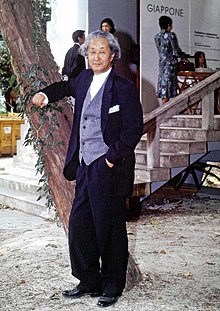Arata Isozaki
[1] Isozaki's early projects were influenced by European experiences with a style mixed between "New Brutalism" and "Metabolist Architecture" (Oita Medical Hall, 1959–1960), according to Reyner Banham.His style continued to evolve with buildings such as the Fujimi Country Club (1973–74) and Kitakyushu Central Library (1973–74).Later he developed a more modernistic style with buildings such as the Art Tower of Mito (1986–90) and Domus-Casa del Hombre (1991–1995) in Galicia, Spain.In 1983, he supported an apparently unbuildable entry for a sports club in Hong Kong by the then-unknown architect Zaha Hadid.[6] The Museum of Contemporary Art (MOCA) in Los Angeles, completed in 1986, was his second international project and his best known work in the U.S.[4] In 2005, Arata Isozaki founded the Italian branch of his office, Arata Isozaki & Andrea Maffei Associates.
Okinawa PrefectureUniversity of TokyoRoyal Gold MedalPritzker PrizePritzker Architecture PrizeColumbia UniversityHarvard UniversityYale Universitypostwar JapanHiroshimaOita PrefectureKenzo TangeMetabolist ArchitectureArt Tower of MitoDomus-Casa del HombreGalicia, SpainMuseum of Contemporary ArtAllianz TowerCityLifeMaranelloArchitectural Institute of JapanRIBA Gold MedalVenice Biennale of ArchitecturePalau Sant JordiArt Tower MitoMito, IbarakiTeam Disney OrlandoCaixaForum BarcelonaŌita, Ōita, JapanKitakyushu Municipal Museum of ArtFukuokaTakasakiLos Angeles, California1992 Summer OlympicsBarcelonaCasals HallPalladium nightclub building interiorNew York CityBrian ClarkeFloridaBond UniversityGold CoastCentre of Japanese Art and TechnologyKrakówNagi Museum Of Contemporary ArtOkayamaKyoto Concert HallNara Centennial HallLake Buena Vista, FloridaDomus: La Casa del HombreA CoruñaShizuoka Performing Arts CenterShizuokaTheatre OlympicsCOSI ColumbusColumbus, OhioShenzhen Cultural CenterShenzhenShenzhen LibraryShenzhen Concert HallIsozaki AteaBilbaoTorino Palasport OlimpicoCentral Academy of Fine ArtsBeijingNew Concert Hall BuildingThessalonikiJianchuan Museum ClusterChengduHo Chi Minh CityColiseum da CoruñaGaliciaEducation CityQatar National Convention CenterAllianz Tower (Il Dritto)Milan, ItalyHarbin Concert HallHarbin, ChinaUniversity of Central AsiacampusesTekeliKazakhstanKyrgyz RepublicKhorogTajikistanNew exit for the Uffizi GalleryBologna Centrale railway stationThe New York TimesMuseum of Modern ArtlaureatesPhilip JohnsonLuis BarragánJames StirlingKevin RocheI. M. PeiRichard MeierHans HolleinGottfried BöhmGordon BunshaftOscar NiemeyerFrank GehryAldo RossiRobert VenturiÁlvaro Siza VieiraFumihiko MakiChristian de PortzamparcTadao AndoRafael MoneoSverre FehnRenzo PianoNorman FosterRem KoolhaasHerzog & de MeuronGlenn MurcuttJørn UtzonZaha HadidThom MaynePaulo Mendes da RochaRichard RogersJean NouvelPeter ZumthorKazuyo SejimaRyue NishizawaEduardo Souto de MouraWang ShuToyo Ito